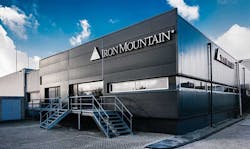In the European data center business, the focus is on FLAP – short for Frankfurt, London, Amsterdam and Paris. These four cities are the primary markets for new data center deployments, as developers from both the U.S. and Europe undertake expansions.
The growth in the FLAP markets, along with continued progress in sites like Dublin and Marseilles, made 2019 a record year for the European colocation sector with more than 200 megawatts of leasing. That’s according to CBRE. which expects wholesale leasing in 2020 will exceed that record, despite the challenges posed by the global COVID-19 pandemic.
“CBRE has a line of sight to 160MW of take-up in the year from the existing pre-lets, options and capacity currently under offer or in negotiation across the FLAP markets,” the report from CBRE’s Andrew Jay and Mitul Patel. “Therefore, 200MW of take-up is comfortably achievable and could be exceeded if the cloud providers accelerate their procurement of future capacity, as a result of the increase in demand for their services.”
After this week’s announcement of a 27-megawatt hyperscale lease at Iron Mountain’s FRA-1 campus in Frankfurt, Data Center Frontier had a Q-and-A with Eric Boonstra, VP and GM for Western Europe at Iron Mountain Data Centers, about Iron Mountain’s progress and the European data center market.
Data Center Frontier: At 27 megawatts, this lease launches Iron Mountain into the upper tier of service providers provisioning large-scale capacity. Do these massive deals require a different approach to data center design and development, or is it simply the usual process, only at larger scale?
ERIC BOONSTRA, Iron Mountain
Eric Boonstra: To be honest, it is a different way of building. At Iron Mountain Data Centers we’re focused on serving retail, enterprise and hyperscale size clients. With that in mind, design and construction with these different sets of customers is something we consider when building a new data center. For retail customers, a couple of racks or a module works fine providing them a fully fitted out solution, but hyperscale customers need a different approach. To start, they simply require a lot of whitespace and it happens that they have specific requirements which need to be taken care of in the design. The approach is different as well, as some providers are looking for a powered shell and want to know the amount of MW’s and some need a more fitted out solution where we help them out with more than just the basics. It’s really about thinking along with the customer to create mutually beneficial solutions where we can serve as a long term partner for data protection, connection and activation.
Data Center Frontier: We’re seeing reports of strong demand in major European markets. What are the attributes of Frankfurt that support these large-scale deployments? Do you expect to see more of these large deals in Frankfurt?
Eric Boonstra: It’s true that we also see similar interest with a lot of demand for Frankfurt but also for London and in Amsterdam. Although the market in Amsterdam differs a bit since hyperscalers are more focused on building their own data centers over there. Still we also see demand for colocation in Amsterdam as well. Some of the unique features of Frankfurt and Amsterdam are their locations. Both are well known for being great interconnection hubs and besides the rich connectivity, the strategic locations make for easy inroads to western and eastern Europe where a lot of business is coming from, whether your an European, APAC or US based organisation.
Because of all the infrastructure that is already in place in Frankfurt, we’re seeing and expecting more hyperscale demand to come in Frankfurt next to London and Amsterdam as those are the main regions to land and expand in Europe.
Data Center Frontier: What are the current prospects for Iron Mountain in Amsterdam? And what is the latest on the discussions regarding data center development and the region’s capacity for new projects?
Eric Boonstra: As mentioned earlier, the focus for IMDC is retail, enterprise and hyperscale customers. Our AMS-1 Amsterdam campus has its roots as being a retail campus with over 50+ connectivity providers and PoP’s of the main internet exchanges AMS-IX and NL-IX providing low latency and carrier neutral connectivity options for custom solutions. So, it’s safe to say that this is a genuine connectivity hub. But as AMS-1 is a campus facility, we have the space and power to build on our campus and also serve hyperscale customers next to retail.
The Amsterdam region is somewhat reluctant in providing new permits for new data center builds. When you look at our campus facility, we are happy to say that our AMS-1 location falls out of the current building jurisdiction. Our AMS-1 data center campus now has 12 megawatts of capacity, with the ability to expand its campus footprint by more than 20 incremental megawatts. We are currently expanding the campus, adding 1.7 megawatts of capacity, of which 18% is pre-leased, which reflects strong demand from both new and existing data center customers.
Next to that I’m happy to say that we have secured a second location in Slough where we will build our LON-2 data center, adding an incremental 25MW of capacity. This combined with a healthy looking pipeline will help tremendously in growing the business for the future.
About the Author


